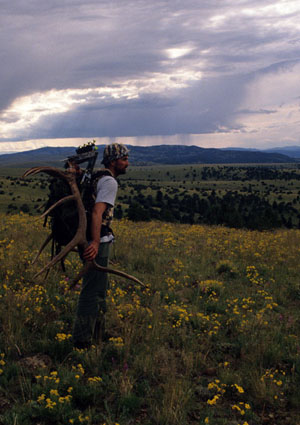Most Western game's outright allergic to hunting pressure, so hunting off the beaten track is standard procedure. Hiking in and out of these remote areas takes a toll, though. You will have more success and save some effort if you plan ahead and know what to take.
Choose High-Tech Gear For Comfort
 Backpacking places backcountry game within easier reach. Fortunately modern technology makes this easier without sacrificing comfort or function when weather turns nasty. Lighter-weight backpack stoves, lanterns, cookware, food, high-tech sleeping bags, pads, and tents literally take pounds off your back. The best backpacking gear doesn't come cheap, but assures a comfortable experience.
Backpacking places backcountry game within easier reach. Fortunately modern technology makes this easier without sacrificing comfort or function when weather turns nasty. Lighter-weight backpack stoves, lanterns, cookware, food, high-tech sleeping bags, pads, and tents literally take pounds off your back. The best backpacking gear doesn't come cheap, but assures a comfortable experience.
The local backpack shop is also the place to get fitted for a new pack. If your pack's more than 10 years old, you're missing out on a world of comfort. A perfectly fitted pack is as important as perfectly fitted boots. Old-style external-frame packs are useful for schlepping elk quarters from canyon bottoms or toting Alaskan moose meat across bog, but they are not as comfortable over long miles.
Find Your Hotspot Before Leaving Home
Backcountry reconnaissance to locate hotspots is difficult (though it is a good excuse for a summer trout fishing trip or adventure). Maps are a better start. U.S. Forest Service, BLM, or U.S. Geological Survey maps get you into desolate areas effortlessly. Indexed to accurate topographical maps, today's GPS units can take you right in and get you home safely. Wilderness areas are obvious objectives, but any large piece of roadless terrain offers potential. Basic knowledge of game and preferred habitat also proves useful. Water is always important, so permanent creeks, springs, or even man-made drinkers or tanks are prime locations.
Also talk to government employees who know the area you have in mind. State game biologists often fly aerial surveys. Summer fire crews are often a great well of information. Look at the state wildlife division’s annual harvest statistics. Good bets are areas with success rates above 25 percent for deer, 30 percent for elk, and 50 percent on turkey. The Natural Resources Conservation Service (formally Soil Conservation) collects data on flora and fauna. Their reports can lead to specific food supplies, water, and animal populations in a particular area. Get more info at the NRCS website.
Another sometimes productive—and fun—way to scout is through on-line aerial photography websites. Check out TerraServer USA, GlobeXplorer, and U.S. Geological Survey aerial surveys.
Invite A Friend For Companionship And Safety
Finding a reliable hunting partner to share a backpacking hunt into remote backcountry can prove the biggest challenge. Backpacking solo is not wise for obvious safety reasons. Besides, great hunting deserves great company, someone to assure you arrive in camp safely at the end of each day, to share the burden of packing meat and antlers, and, most importantly, to exchange tales around the fire at the end of a fine day. Bowhunting just doesn't get any better than that.






